Behind the Scenes of Dear Devere
Hullo and welcome! This is the big behind-the-scenes article I've written on how I made the visual novel Dear Devere.
I made this in the hope that it can show you the process.
This article contains spoilers the Dear Devere. Please play the visual novel before reading through this.
Initial Inspiration
For the longest time, I've wanted to make something using digital collage art. I wasn't sure for what exactly (I wasn't even sure whether it would be for a visual novel), because I didn't have a story idea to go with it.
I've also wanted to make a game where you explore pages of something (such as a scrapbook) ever since I played Uncle Albert's Fabulous Voyage (1999) as a child. The game had a major bug in the PC version, preventing me from ever completing the game, but what I could play I enjoyed immensely. You explored an old, magic journal created by the protagonist's uncle (an eccentric explorer), collecting items to help fix a machine that would "save" the journal, which was falling apart.
- Video: A playthrough of the French version of the game. English playthrough videos are rare.
Then I came up with an idea for a story about a human woman and a supernatural being (at this point in the outline, a demon) who team up to get revenge on some people who have wronged the woman. I wanted the story's theme to be about how the "the real demons are within us," and was a very different story than what Dear Devere eventually became.
I think I was partly inspired by the Beetlejuice musical, which I had discovered recently prior to coming up with the story idea. The idea of a supernatural being teaming up with a snarky woman is a very specific genre that I love for some reason.
I was also inspired by The Haunting of Cassie Palmer, a 1981 British series. I've never been able to watch it (finding copies of it in a good audio/video quality are too rare), and while you may be wondering how I could have been inspired by something I've never watched, I read the Wikipedia page of its plot synopsis.
To sum it up, the series was about a girl named Cassie who accidentally summons a spirit named Deverill (which helped inspire Devere's name), and together, they try to find buried treasure to save Cassie's mother from dept.
The song Soldier, Poet, King by The Oh Hellos was a big inspiration to the atmosphere of the game. In fact, I cited Soldier, Poet, King to Dear Devere's musician (Paul Robins) when we discussed ideas about the VN's soundtrack.
Not only was The Oh Hellos' folk music an source of inspiration, but also their cover design for the Dear Wormwood album (made to look like a square envelope, complete with postage stamps). "Wormwood" is a reference to The Screwtape Letters by CS Lewis, which is a novel about a demon sending letters on how to tempt humans, which also became an influence on Dear Devere's initial outline.
Griffin and Sabine
The Griffin and Sabine trilogy had such a major impact on Dear Devere that I cited it as such in the visual novel's credits.
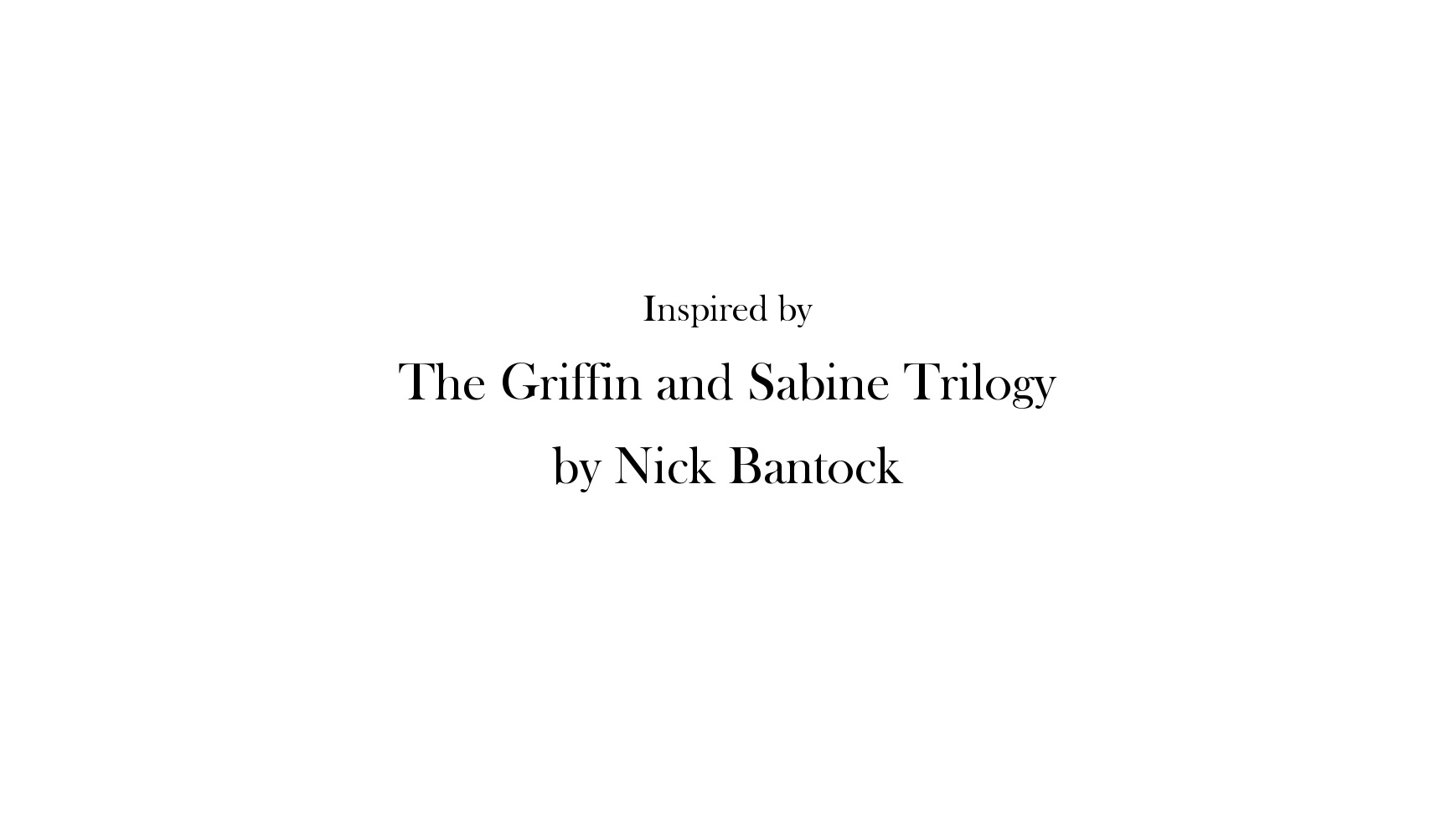
[Image: From Dear Devere's end credits.]
In Austin's Kleon's book, Keep Going, he has a sub-chapter titled, "Slow Down and Draw Things Out." In it, he talks about looking at one piece of art for an hour. Really giving it a proper look. I did this with a copy of Alexandria by Nick Bantock and ended up learning so much about collage art.
Alexandria is one of the many books in the Griffin and Sabine series.
Griffin and Sabine was a book that I had been introduced to by one of my teachers in high school. It's about Griffin, a man who has a very dull life in London as a postcard artist. He receives a postcard from Sabine, a woman who lives on an island in the Pacific. She claims that for years, she's been having visions of everything he draws, and recently was able to track him down because she recognised one of his postcards. From there, the book unfolds into a really intriguing story.
What makes Griffin and Sabine very outstanding is that the story is told through postcards and letters, which you have to physically pull out and unfold to read.
[Video: A person flipping through a copy of The Pharos Gate, another book from the Griffin and Sabine series.]
The presentation of Dear Devere was influenced by The Ceremony of Innocence (1997), a video game adaptation of the first three books from the Griffin and Sabine series. I never got to play it myself (due to its age and rarity), but I was able to watch a longplay of it.
- Video: A longplay video of The Ceremony of Innocence.
Griffin and Sabine has gotten several different adaptations, including a stage play adaptation, which I referenced in Dear Devere: The armchair in Devere's cave is based on Griffin's armchair and stacks of books from the play.

[Above image: Griffin's armchair to the right in Griffin and Sabine, the stage play.]

[Image: Devere's armchair in Dear Devere.]
First Plot Outlines
Dear Devere went through a lot of different plot summaries before I made the first draft of the script.
Setting
I thought about where and when the story would be set. I considered:
- The Victorian Era
- 1939, WWII
- Moscow during 1812
- 1876, Prince Edward Island, Canada (Anne of Green Gables' time period)
- Ireland
Eventually, I went with the Isle of Mull. There's something very beautiful about Scotland's islands. They invite magic.
The First Summary
I kept a plot summary of what I began with. I've edited it to make it easier to read, grammatically-correct, and less nonsensical.
- A girl starts leaving letters under a rock, addressed to an entity named "Devere Deverard." It becomes apparent that Devere is a demon or fae, and the girl is named Angela and is writing to him for company.
- There is talk about the village she lives in being harassed by evil spirits, asking for Devere's help on getting rid of them. He does so in unconventional ways (instead of fighting them, he has Angela talk to them, hang up magical repellents, etc).
- Devere does not wish to meet with Angela physically, explaining that his body would be weakened upon human observation. The malevolent spirits are discovered to be the spirits of animals, plant life, and even older buildings that have been destroyed to make room for the village's expansion.
- Angela is able to get rid of these spirits through a series of improvised exorcisms, wherein she scares the spirits away. Because, as Devere explains, "There is nothing more powerful than human nature and the human mind. It's frightening." Eventually, the two get to know each other through their correspondence, and develop a friendship. Their relationship begins to become romantic, though Angela questions the demon's genuineness, despite his reassurances and kind gestures. "Beware those that talk with a smooth tongue."
- They talk about what they would do together if they became a couple: Devere's descriptions are romantic, while Angela's are (to the observant reader) subtly more possessive and controlling, foreshadowing things to come. "I keep you jealously to myself."
- Eventually, they agree to meet at a certain spot on the island. A final letter by Angela is left, warning other demons to never enter the village again, as she will "deal with them too," implying that she exorcised Devere. She writes that she has also left the letters she received, no longer wanting them in her home.
As you can see, Dear Devere in this version would have been a visual novel with a bleaker ending. Cailin wasn't even a character at this stage of pre-production. I changed the story because I found the romance between Angela and Devere to be more interesting and so their relationship became more kind-hearted.
The Plot Twists
In early versions of the VN, the twist was going to be that Angela betrays Devere in the end in some way. This was to cement the game's theme of humanity being worse than the demons and monsters it makes up.
Some early ideas I had that were cut or changed:
- Angela writes several letters (to the point where the player realises more slowly that she is writing to no one) before Devere responds.
- During the letter wherein Angela asks Devere questions about himself, Angela asks, "Where do you get your stamps?" Devere replies with a monologue about the history of the printing press and how it affected the distribution of religious texts. This was meant to be a reference to Mark Twain's novel, No 44 The Mysterious Stranger. A book about a group of kids in a small town finding a handsome teenager (named Number 44) who claims to be an angel, but they eventually realise that he is a fallen angel.
- In early versions of the story, Angela lived with her grandmother. Cailin would eventually try to convince Angela's grandmother to let him stay at her and Angela's house.
- The Inspector was a person from modern day (2020s) who was trying to solve a really cold case. The player would be told that ancestry experts had found records of Angela existing around the time of the correspondence, but no records of Devere.
- The Inspector had a boyfriend (a fellow agent of the Bureau) who wanted a response on whether they should continue their relationship. The Inspector's reading of Angela and Devere's letters was meant to be a narrative parallel to their own romantic relationship. In the end, the player would choose whether or not they decided to stay in the relationship (despite external obstacles) or not.
- Ending idea: Angela is eventually convinced that Devere is not real. She stops sending letters to him.
- Ending idea: If the player decides to protect Angela and Devere from the Bureau, the game would cut to a black screen, with the sound of a door being knocked, followed by a letter being dropped through a letterbox. The player opens the letter they've received. It's a letter of thanks signed by "Devere Bard," (Angela's last name) implying a union.
On the Writing
The Process
The visual novel was written in Scrivener, which is a program that I really like using.
Scrivener lets the writer organise the different scenes into pages that can be re-arranged in the program's binder, which helps you organise things. I also kept pages for research notes and reference.
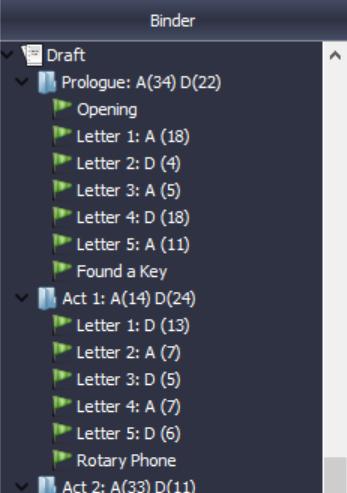

[Image: A screenshot of the different pages in Scrivener's binder while I was writing Dear Devere.]
The script was then copy/pasted into Google Docs to be proofread by the proofreaders.
What is Devere?
I decided to mix various different supernatural beings for Devere and have the player decide what he is. The most notable ones are demons, the fae, selkies, werewolves, and wendigos. I like leaving certain things open-ended in my work so that the players can come up with their own interpretations. It's part of the interactive nature of storytelling.
"You miserable dreich-beast."
Cailin's insult to Devere is a reference to the word "dreich." A Scottish word used to describe the weather when it’s cold and damp.
Devere's Poem
I looked up Victorian poetry for inspiration. Specifically:
- The Fairy Lover by Moireen Fox
- Do Not Worry by Alan L. Strang
- The Blonde Maiden by Bjornstjerne Martinius Bjornson
"What's for you won't go by you."
This expression that the Captain uses is a Scottish proverb (aka "Whit's Fur Ye'll No Go By Ye"). It can be interpreted to mean that Fate won't let you miss things that you're meant to see or experience.
Mushrooms in Scotland
I ended up watching this video on edible mushrooms in Scotland for research purposes for the game. I ended up learning that Scotland is an excellent place for finding mushrooms (due to its climate and forests) and that mushroom varieties have vastly different tastes from each other.
The Player Character
Coming up with the player being the Inspector really helped with organising the story, because it answered the question, "Who is reading all of these letters?" It added a context.
I also made sure to have all the player character's dialogue be choices that the player needed to click on to progress, even if they only had one choice to select. This added some interactivity for the player, as well as helping to make the player feel that it was them doing these things. They are making a conscious choice to light the match.
Scotland, Australia, England, and Outsiders
After choosing Angela's voice actress, Chintarmanya Vivian, Angela was re-written as being from Australia. This ended up being a change I really like, as it makes both Angela and Devere (who I wrote as being English as early as the first draft) outsiders of New Sorne in some way.
It has been said by critics that many monster/alien films I like (The Iron Giant, E.T. The Extra-Terrestrial, Lilo and Stitch, Beauty and the Beast) tend to have similar staples to the genre: One of which is the human who meets the monster/alien also being an outsider of their community in some way (they're seen as too different in some way). This allows the human protagonist to relate to the monster/alien quickly.
And with the monster character in these works now framed as being one of the good guys (rather than a villainous monster that needs to be slain), the human character who tries to kill the "monster" goes from being a heroic lead to the villain role themselves (in Dear Devere's case, Cailin). Cailin and Devere become the two answers to the question, "Who is the real monster (answer: Cailin) and who is the man? (Devere)" For more information on this, I highly recommend checking out this video essay on monster movies by Lindsay Ellis.
I prefer the stories where the monster is the good guy. I find those stories relatable.
On the Names
Devere = Devil. Angela = Angel. Cailin = Cain (The First Murderer).
Yes, it really was that simple. I always struggle with coming up with character names.
I also went down the alphabet: Eliza Frame, Capt. Graham, etc.
Some of the members (Agent Dunter and Agent Morool) of the Bureau are named after Scottish folklore creatures. Dunters are similar to the red caps, being creatures that haunt old, ruined fortresses. They are thought to be the folk memory of foundation sacrifices. Morools are a Shetland sea monster with many eyes.
I was close to naming Devere "Deveral" as well as "Devere" (a reference to Mr Richard DeVere from the British sitcom series To the Manor Born). But I eventually went with Devere.
When they first start writing letters to each other, Angela and Devere address each other as "Mr Devere" and "Miss Angela Bard," respectively. Then they start removing the honorifics. Then after they confess their love to each other, they use "Dearest." It's an arc I'm happy with!
New Sorne
The town of New Sorne is a fictional town based on the real township of Sorn that was cleared away in the 1850s to make way for Glengorm Castle. Glengorm Castle is shown in the map Angela draws for Devere, implying that the visual novel is set in an alternate timeline where the town was re-built a few miles from its original spot, and re-named New Sorne. The placement of the castle's location to Ardmore Forest (both located on the Isle of Mull, Scotland) I tried to keep accurate.
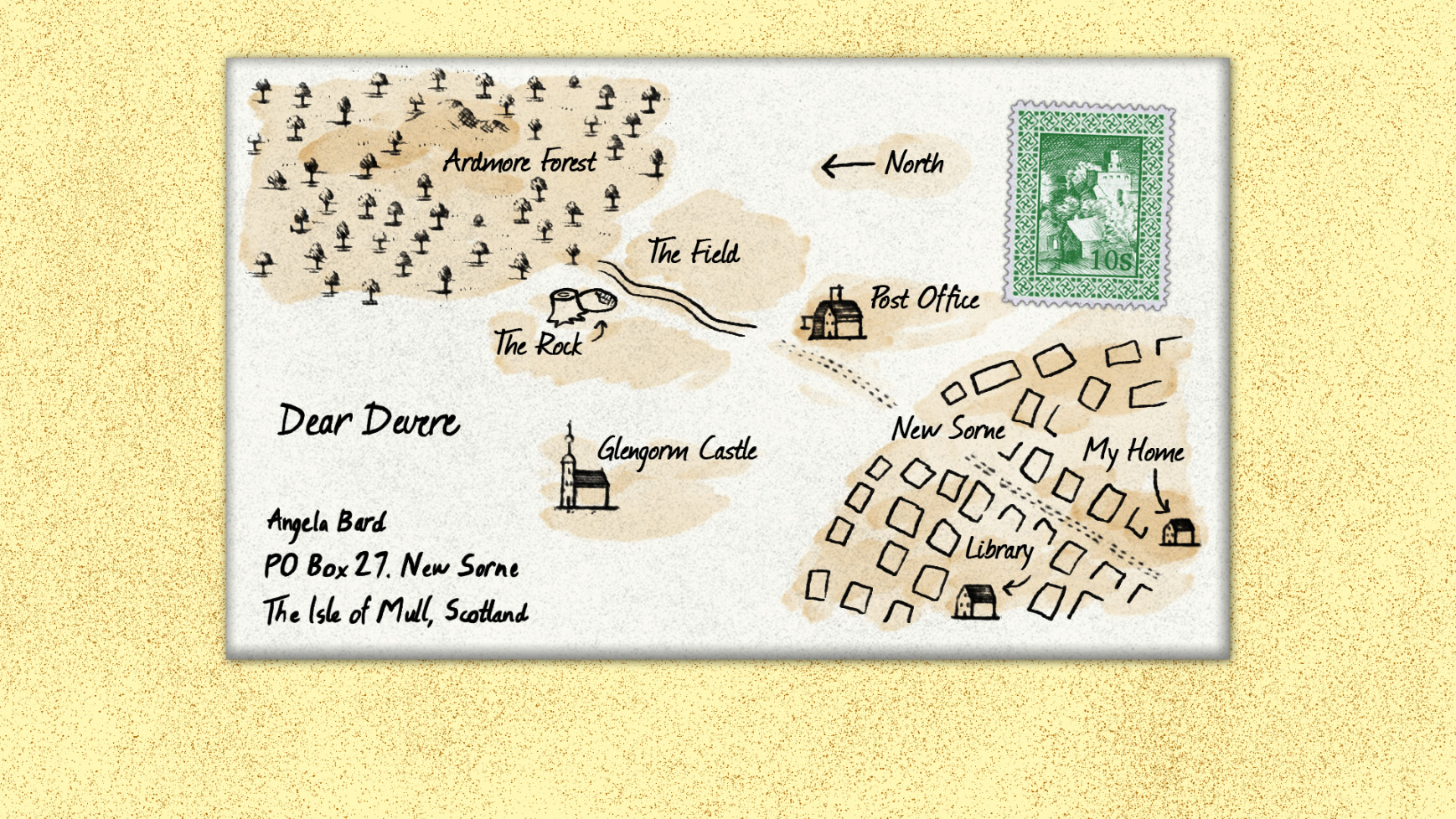
[Image: Angela's map of her town and the outlying land.]
A Note on Current Events
March 2020 was a pretty life-changing month for people around the world. Dear Devere was made during NaNoRenO 2020, a month-long game jam held in March.
One of the strange phenomenons about creating art is that sometimes, you end up accidentally predicting things or accidentally making something that ends up feeling timely by the time you've completed it.
I've noted before through this meme that Dear Devere's themes of isolation, venting, and finding worthwhile long-distance relationships was purely coincidental. If you look at the VN's production as a timeline, the script was completed (and essentially locked--edited only to fix typos and edit out plot holes) within week 1, and I started fully understanding and realising how bad Current Events were around week 3, when I was told to work from home.
That isn't to say that Current Events didn't affect the game. It did. Just perhaps not in the most obvious ways. Games are not made in a bubble.
Voice Acting
The Three Documents
I sent three main documents to the voice actors:
- An Audition Document.
- A Voice Acting Info document.
- And a Voice Acting Spreadsheet.
These were shared through Google Drive.
After I got in touch with the voice actors (Chintarmanya Vivian and Mike Young), I sent them an Audition Document.
In this Audition Document, I included:
- A description of the game (the story's premise, the art style, and the game's inspiration)
- Descriptions of Angela and Devere.
- Three audition lines for each character, along with context for each line. The lines were chosen for their different emotional range.
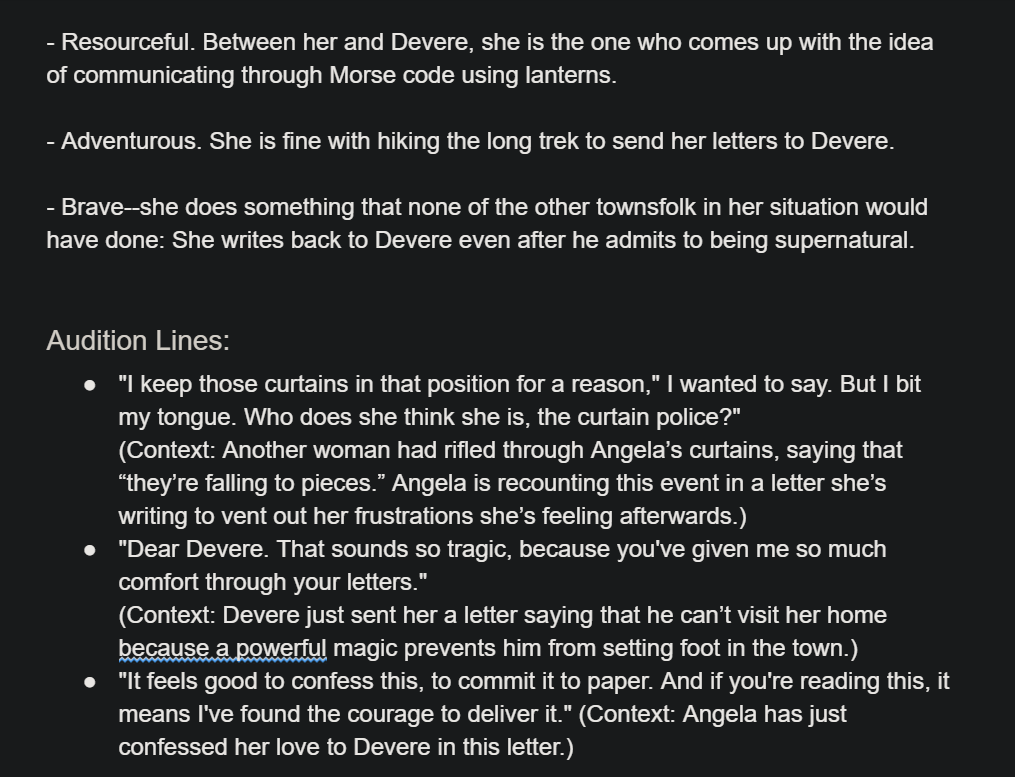
[Images: Screenshots from the audition document.]

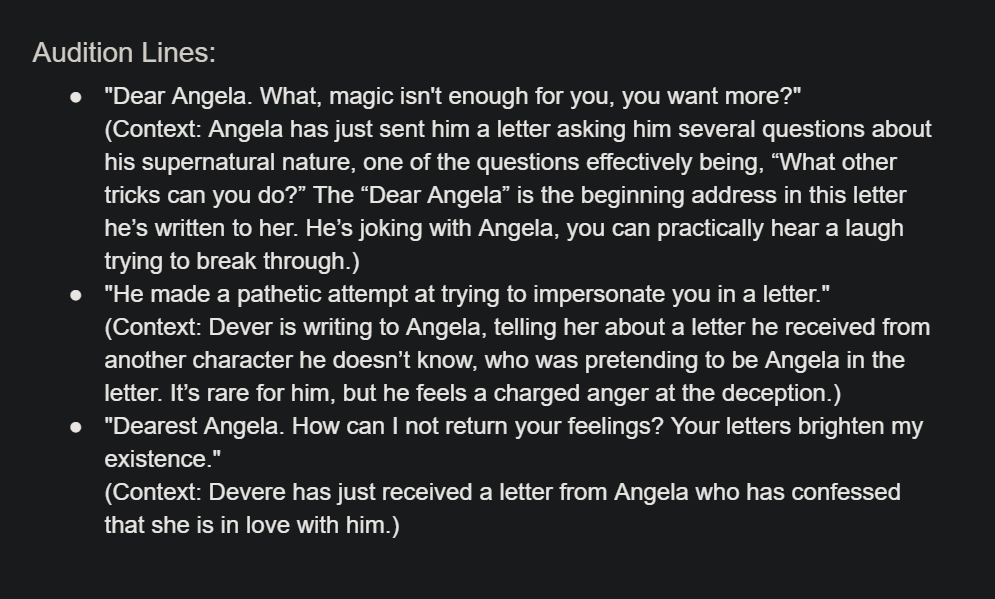
After I received the voice acting clips from both of them, I gave feedback, and sent them the Voice Acting Spreadsheet and a Voice Acting Info document.
The Voice Acting Info document included:
- Instructions (due dates, what format to send the voice clips in).
- Content warnings (swear words and any mentioned violence or adult themes).
- The total number of lines for each character.
- A list of updates to the voice acting spreadsheet (this had to be updated and dated every time a change was made to the voice acting spreadsheet).
Along with the Voice Acting Info document, I sent them a Voice Acting Spreadsheet. Which brings us to...
How Ayu Saved Me Without Realising It
Back in January 2018, Ayu (of Sakevisual) gave a talk at the yearly visual novel conference, VN Conf. In her webinar, she talked about including voice acting in your visual novel.
In the talk, she covered several things about voice acting. I recommend watching the entire video, but one of the things she discussed was creating a Voice Acting Spreadsheet: A spreadsheet dividing each line of your VN's voice acting into different rows, while also labelling each line with notes placed in different columns.
I used this to make the Voice Acting Spreadsheet, dividing each line into rows, with the following columns:
- Character: Who is saying the line.
- Line: A line was the amount of text that would be displayed in the textbox before the player clicks to continue.
- Context: An explanation of the context of the line. What the character is thinking, what they are referring to, subtext, and name pronunciation.
- Line Number: What the audio file would be saved as. Each line number was divided into three sections: The act is was in (A=Prologue, B=Act 1, C=Act 2, etc), the letter it was in (01, 02, 03, etc), and the order it is in that letter (01, 02, 03, etc). So for example, A-01-02 would be the second line (02) in the first letter (01) shown in the Prologue (A).
- Notes: If I needed to change a line, I'd write in this box what I changed, and when (an exact date).
- Recorded?: A checkbox. I was meant to check mark these boxes when the line was recorded.
- Added to VN?: A checkbox. I was meant to check mark these boxes when the line was added to the visual novel's script.
The last two columns (Recorded? and Added to VN?) I ended up not updating properly (I thought adding the audio into the visual novel's script would be an ongoing process, but I ended up doing the majority of it in one day). But the Line Number ended up really helping to organise the lines for both myself and the voice actors.
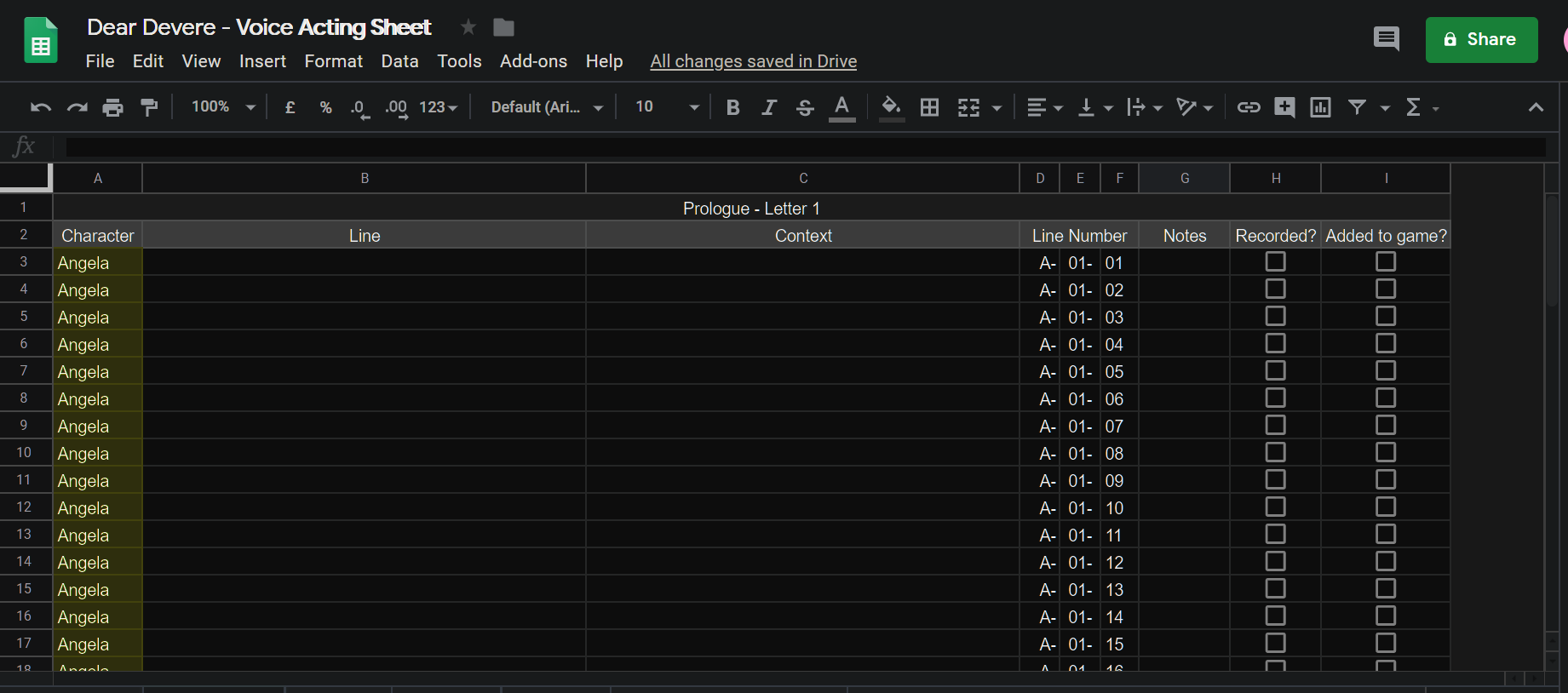
[Image: The Voice Acting Spreadsheet when it was blank.]

[Images: The Voice Acting Spreadsheet.]


In a Tweet she wrote during NaNoRenO 2020's jam, she gave the following advice, "If you intend to have your VN voiced, you must finish your script within the first two weeks. Plan accordingly."
Ayu's advice ended up saving me.
Writing and finishing the script within the first week allowed me to send it out to Dear Devere's proofreaders (Rowan, lunaterra, HusbandoGoddess, and Jacob), which let them have more time to look for typos and grammatical errors, which in turn gave me more time to add the script changes needed before releasing the game.
Writing and finishing the script within the first week also allowed me to send it the Voice Acting Spreadsheet to both of the voice actors sooner, this gave me more time to listen to each line, place them into the visual novel, and send back any notes back to the voice actors for retakes (there were very few--I was very happy with the reads both voice actors gave me on their lines). It was a domino effect.
I wouldn't have had enough time to finish making the game before NaNoRenO 2020's deadline if I didn't follow Ayu's advice. Thank you, Ayu.
Programming That Was Cut
I considered including an unlockable ending (which would have been the Epilogue used in the final version of the game) where the player looks for "familiars" hidden around the visual novel. These were based on the familiars in The Trickster's Hat by Nick Bantock (a book of art project exercises). The end of the book contained a list of familiars that you could find hidden throughout the pages of the book.
This was cut because, 1) It required programming several different things (and I was trying to scale down because this was a NaNoRenO game jam). And, 2) I felt that placing the Epilogue behind a hidden object puzzle would have prevented many players from seeing it, which I felt wasn't a good idea, since the Epilogue added a lot of context (it confirmed that Devere was supernatural, to any players still wondering) and catharsis (Angela and Devere finally being together and having a conversation in the same space).
I also planned on adding click-able hotspots the player needs to click on to explore (and by "explore," I mean, "move forward") the cave. I cut it to scale down on additional programming.
The Art
The Collage Art Process
Dear Devere's art was created in Photoshop using a combination of stock images, public domain images, and custom brushes.
Several of the brushes used were from Kyle T Webster, who releases brushes on his Gumroad page. One of his brushes (called Paintbox Cool Drag) helped me create the "ripped" paper edges in the art, which helped speed up the art-marking process because the alternative would have been using actual photos of ripped paper.
Here are some diagrams I made showing the process of creating some of the different art assets:
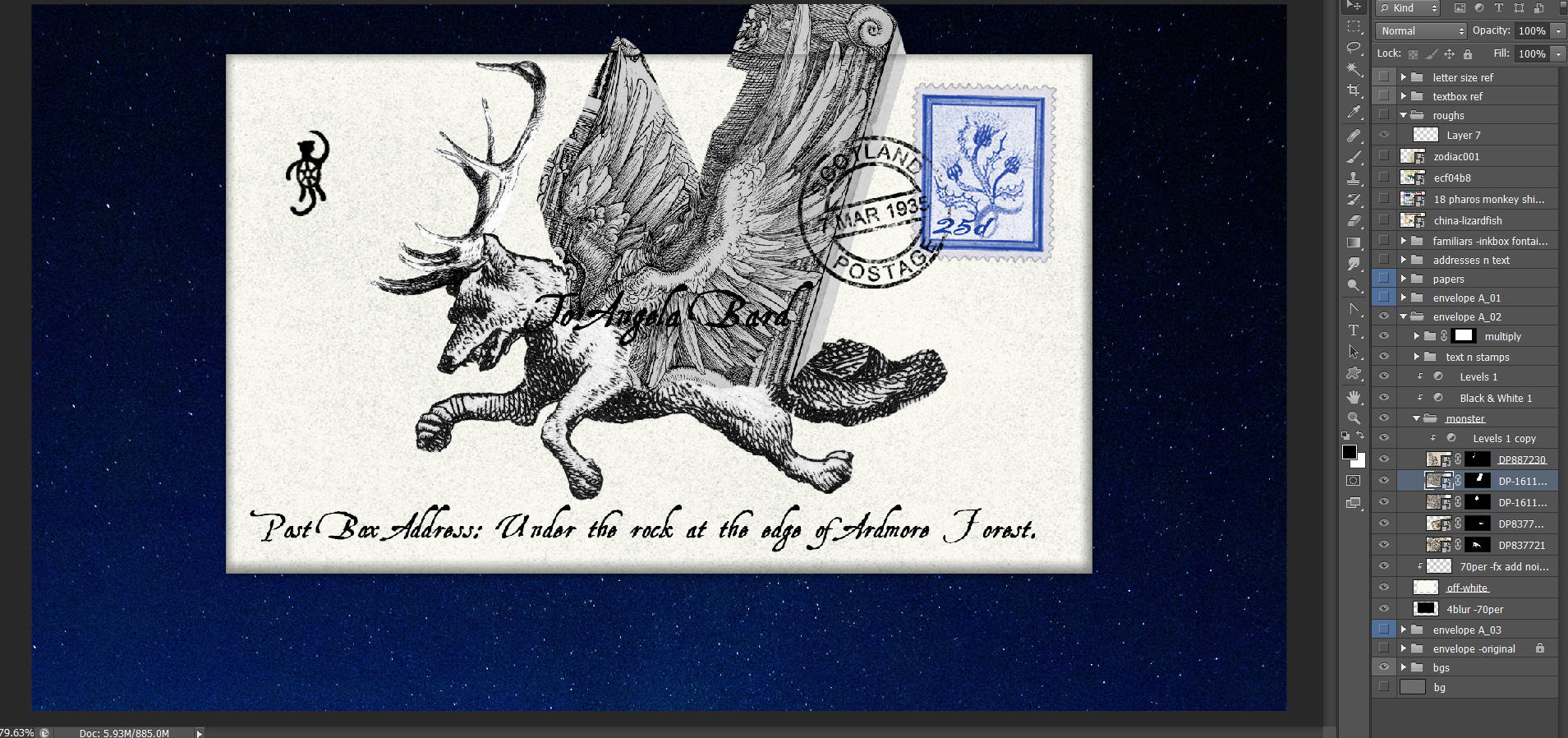
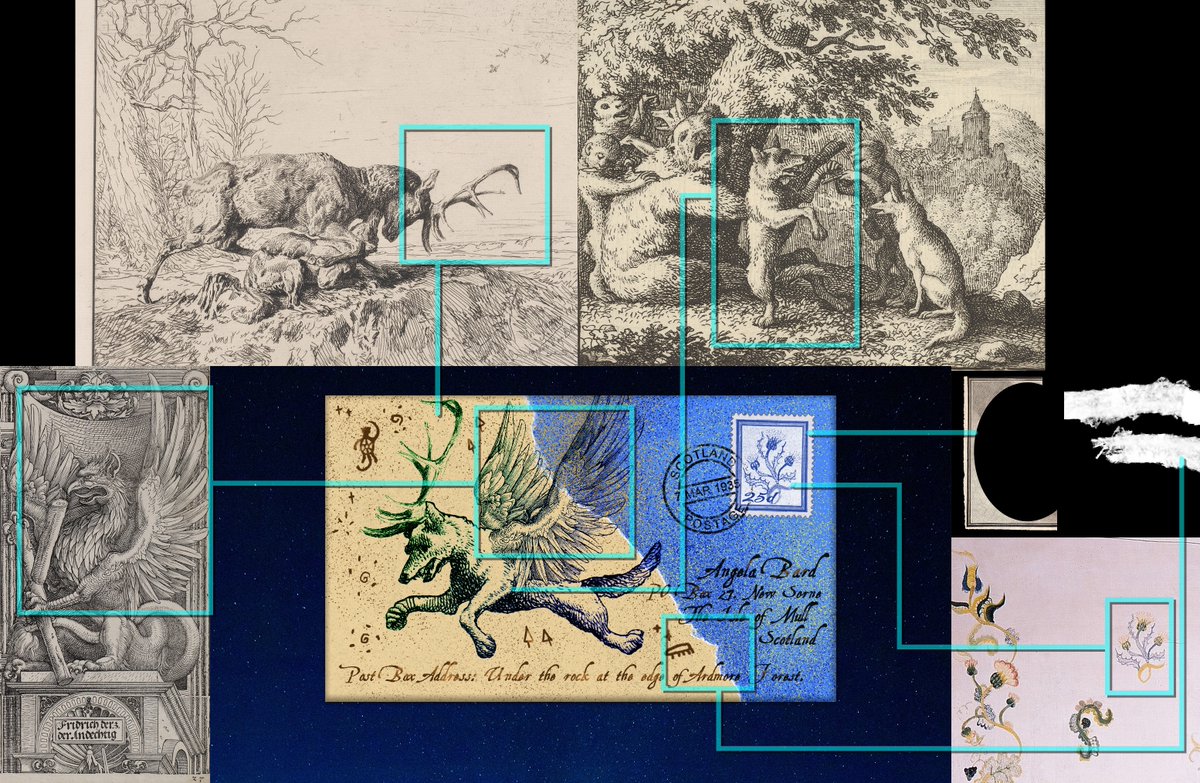
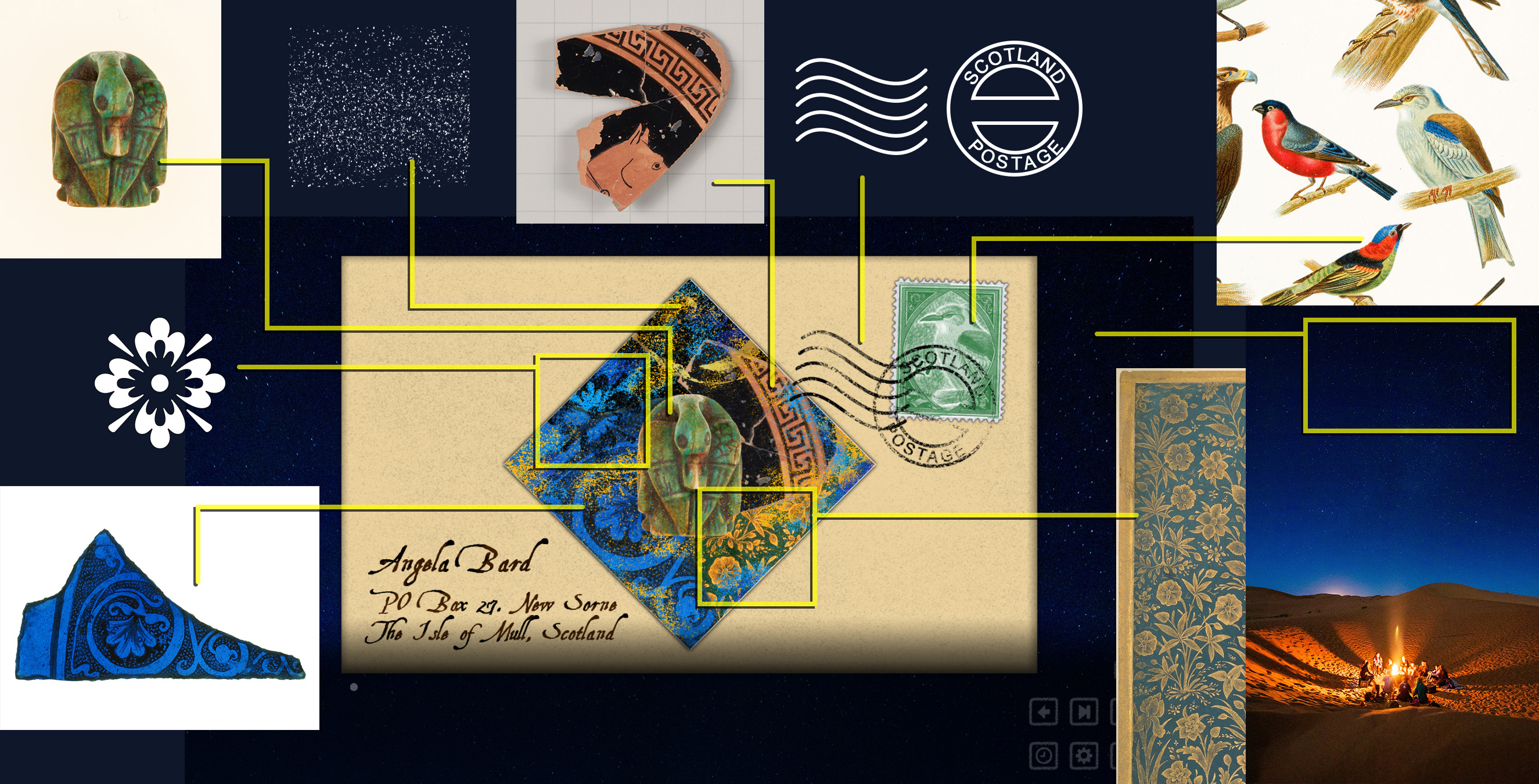






The Esoteric
I wanted each of Devere's (and later, Angela's) envelopes to be symbol-heavy for players to look at, linger on, and interpret.
Interpreting the envelopes can be a bit like reading tarot cards. The different elements can symbolise multiple things
I don't want to go through each envelope and analyse them because I want players to come up with their own interpretations. Instead, I'll briefly make some notes from two envelopes:

The playing cards glued onto the envelope:
- The cards are of the ace of hearts, representing love.
- The two pieces are red and black, representing opposites (Angela and Devere are foils to each other).
- The ace in a card deck can also symbolise asexuality (Angela being possibly ace--she is romantically-attracted to Devere, and when she sleeps next to Devere, that's all that happens: Sleep). I wrote Angela as being ace.
- Two cards are ripped: Meaning two halves finding each other (Angela and Devere finding each other and being each other's half).

Devere's final letter to Angela:
- The wolf's eyes being covered by gold paint: It is similar to a censor bar, making the wooden wolf (representing the forest-dweller, Devere) anonymous. Here, we question whether we really know him, or if he has been lying to us.
- The gold paint is also the same gold paint used in Devere's earlier letters (specifically, the letter wherein he talked about an "old magic" preventing him from entering the town). This creates an association: Gold can represent magic. So the wolf's (Devere's) eyes (his identity) is being blocked by magic.
- An alternate reading from the one directly above can be that Devere is using magic to hide his identity (meaning, he lied about having magical powers to Angela, which means that she doesn't really know him. You cannot know a liar who shrouds himself with falsehoods).
- The painting of a starry sky ripped in half: Devere's world is being torn asunder. And he's severing his relationship with Angela.
There's also more literal readings you can make while looking at the envelopes:
Some of the letters have rubber stamps that show the day, month, and year it was received by the post office.

Devere's return address ("Under the rock at the edge of Ardmore Forest") implies his sense of humour.

Devere's letter to Angela confessing his love has two stamps. He really wanted that letter to arrive safely.

Devere's postcard to Cailin is ripped in half. Cailin must have been quite angry.
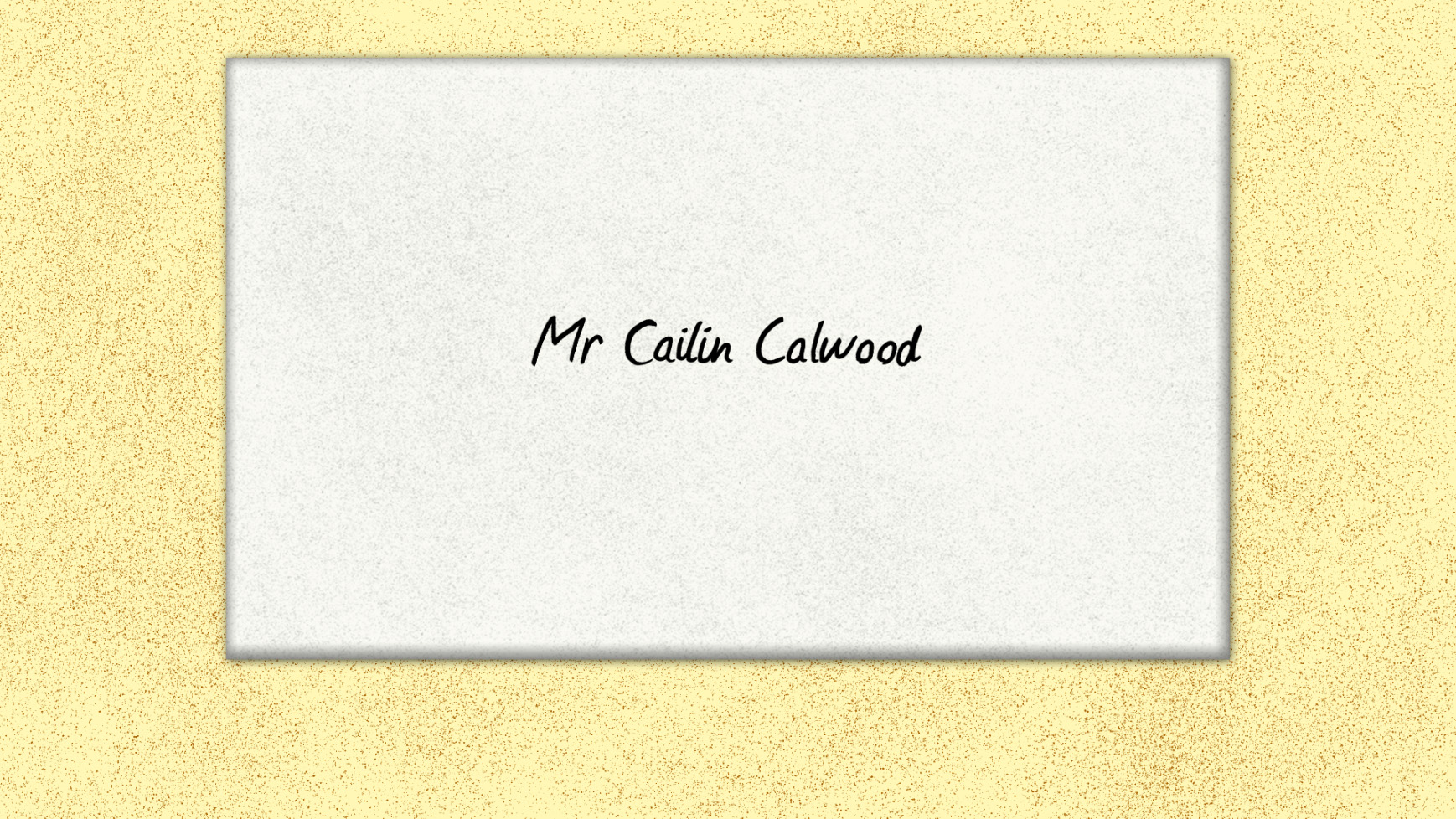
Angela's letter to Cailin has no stamps. 1) Angela wanted the letter to be sent immediately, so she delivered it herself. And, 2) Cailin wasn't worth the stamp.
The Hardest Letter To Create
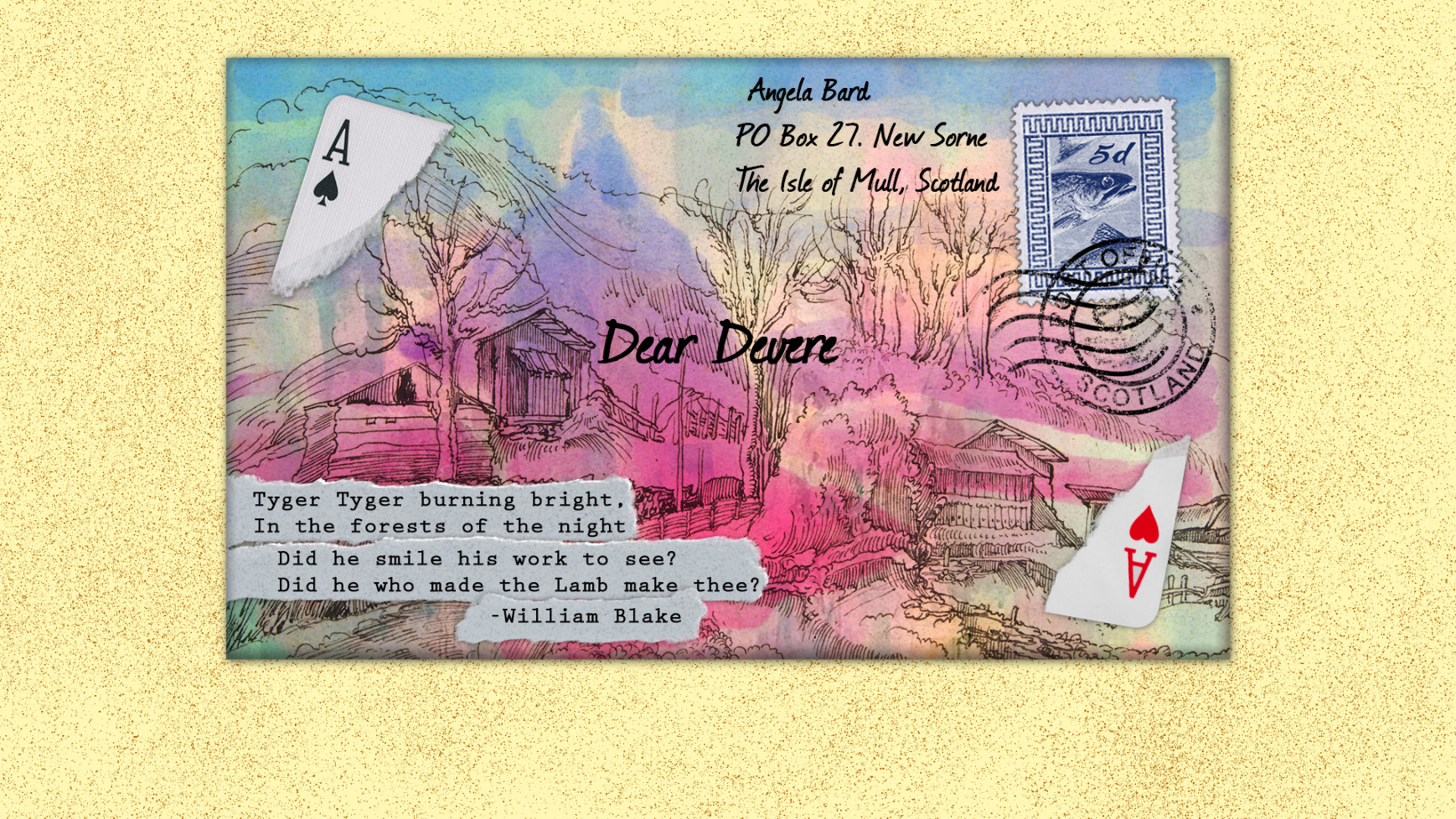
The above letter was the most challenging envelope design I made for Dear Devere. I ended up re-doing it because I wasn't happy with the first design. I'm really glad I did.
This envelope was important to get right because it's the one where Angela talks about the night she spent with Devere. It's a key moment in the story. She also has comparatively a lot of lines in this particular letter, so the player is going to linger on this envelope for a longer time than some of the others.
Note the watercolour image of a pink and blue wolf. It almost fades into the black-inked lineart. In the old version of the artwork, the wolf had dot eyes, which made it look too "cartoony" than what I was aiming for.
The Colour Schemes
I specifically created and picked different backgrounds to create associations between the different characters sending them:
- Angela: Cream colours for the sandy background and the grey stone background. The light, warm cream colours are a nice foil to Devere's darker, cooler colours (blue and green) and the stone is meant to associate Angela with her town on the Isle of Mull (a town with cobblestone roads and many stone rock faces that dot the landscape).
- Devere: Green forest and blue starry night backgrounds. Devere is a being of the forest, and the stars represent his more mystical nature. He is an outsider.
- Cailin: Fiery, ominous red backgrounds. Cailin ends up being more of a demonic monster than Devere (a supernatural being). Red also contrasts with Devere's blue association.
- The Bureau: Blue backgrounds of maps (a blue similar to the official-looking blue envelopes of the Bureau) and rough blacks. Similar in texture to stone, like Angela's stone background but a darker shade (creating a link to her in some way, since they are both of New Sorne in some way). The maps reflect the Bureau's nature (like a map, they try to make sense of chaos). The map I used for the blue backgrounds is of England, implying that the Bureau has agents not just in Scotland.
- The Player: Solid black. The player's interactions happen in a clean black void. It's meant to feel different than the more organic, patterned backgrounds in the game. The player is separated from the rest of the characters. Not just temporally-separated (they enter the story later than all the other characters), but visually too.
A Quick Note on Eyewitness
Dear Devere's logo and main menu design use a solid white background. This clean, minimalist design helps to make the busy, textured envelope design pop.
This design choice was inspired by DK's Eyewitness series, which is a series of guidebooks (and was later adapted into a television series--a great source of 90s childhood nostalgia to me) on various subjects.
The books were revolutionary for their page layout design for nonfiction guidebooks: The blocks of text were broken up with various images from photos that were cut out and placed on a white background (instead of the photos being cropped into a rectangle as it was traditionally done). This was unusual for the time the books were first published, and gave the feeling of the images sitting in a white void.


[Image: The Eyewitness logo.]
Handwriting Fonts
I noticed while reading the Griffin and Sabine series that handwriting is used to convey a lot about the characters (there's stuff I'd like to elaborate on that, but it would go into spoilers that happen in the later books). I tried to keep that in mind while I was choosing the handwriting for the characters in Dear Devere.
The game's title logo uses Baskerville Old Face. Some of the game's UI also uses this font, as well as the narration in the game (the text that doesn't appear in the textbox, but rather on the CGs and backgrounds). I like the typeface's clean yet old-timey aesthetic. It's clear to read, but also feels like it fits with a story set in the 1930s.
Devere's handwriting uses a font called AquilineTwo, while Angela uses a font named Journal. I wanted the their two styles to look distinctly different. AquilineTwo looks very fancy and has curvy lines (I also added mixtures of brown watercolours to his handwriting, making it look like Devere has to mix or make his own ink for his letters). Angela's is more simple and straight, though still having some cursive curves since she's from the 1930s and likes to read a lot. Her ink looks more black (since she's more likely to have access to new, bought inkwells compared to Devere).
Art That Was Cut
Below are some art assets that were made but didn't make it into the final game.
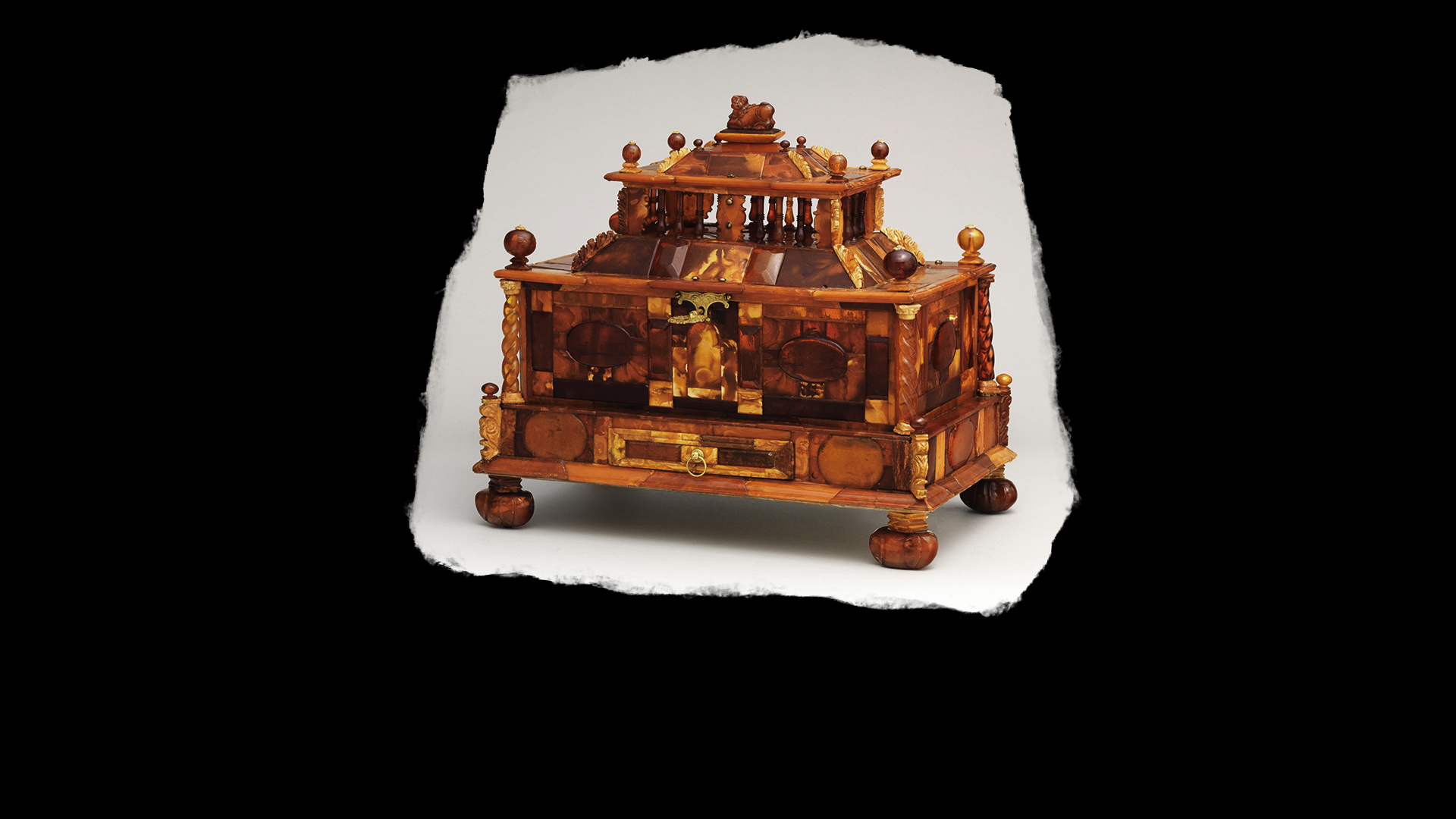
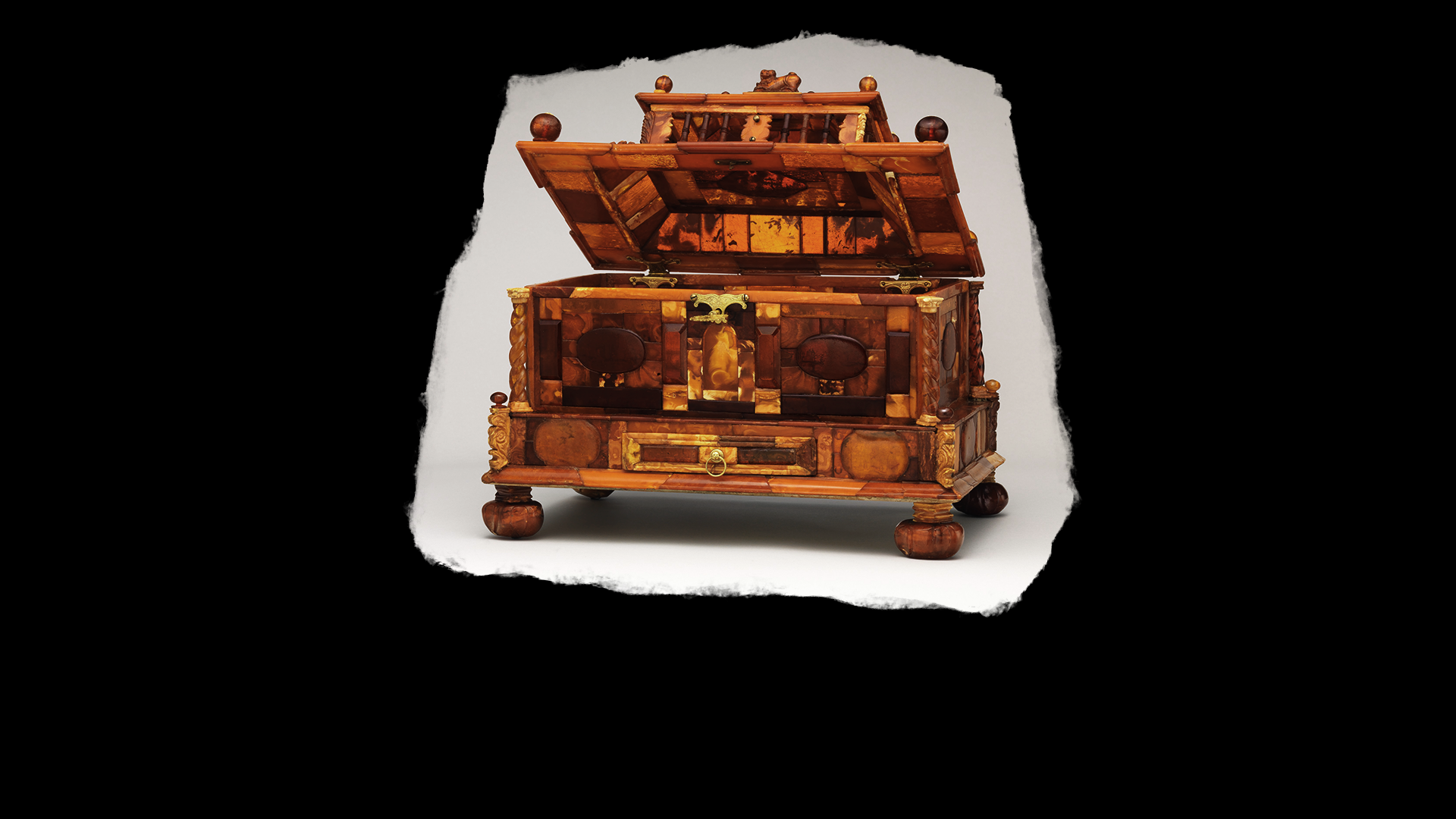
[Images: The jewelled casket some of Devere's letters were kept in.]


[Images: Some more backgrounds for Cailin's letters.]

[Image: A background for Devere's letters.]
Conclusion
So this was my process on creating the visual novel, Dear Devere. Hope it was informative and helpful. If you have any more questions on the game's development, please let me know in the comments.
Turrah,
-Katy133
Get Dear Devere
Dear Devere
An epistolary visual novel.
| Status | Released |
| Author | Katy133 |
| Genre | Visual Novel |
| Tags | Experimental, Hand-drawn, Historical, Mystery, Narrative, Ren'Py, Romance, Story Rich, supernatural |
| Languages | English, Chinese (Simplified) |
| Accessibility | Subtitles, Blind friendly |
More posts
- Dear Devere has a Korean Translation mod78 days ago
- ReviewsAug 14, 2024
- Version 1.5 UpdateJan 01, 2022
- Merch Available! Send a Postcard!Sep 04, 2021
- Version 1.4 Update and Postmortem on TranslationAug 25, 2021
- Dear Devere Now Has a Simplified Chinese Translation (Version 1.3 Updates)Aug 15, 2021
- Dear Devere Nominated at the Steam Awards!Nov 27, 2020
- Devlog 11Jun 28, 2020
- Dear Devere PostmortemJun 22, 2020
- Dear Devere's OST on SteamJun 08, 2020
Comments
Log in with itch.io to leave a comment.
Thank you for documenting and sharing all of this - this is such a font of knowledge! It's been a while since I've made a VN; playing the game and reading this has me itching to start back up.